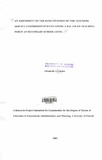Assessment of the effectiveness of the teachers Service commission in maintaining a balanced teaching force at secondary school level

View/
Date
2003Author
Onoka, Elizabeth A
Type
ThesisLanguage
enMetadata
Show full item recordAbstract
The Education sector in Kenya has been in the spotlight m the recent past especially during the era of "cost sharing". Consumers are demanding quality services and expecting good returns on their investments in education. Thus, teacher demand and supply is a central concern to educational planners especially at Secondary school level. Although other forms of technology may be used to enhance the learning process, the direct personal contact between teachers and pupils remain the most effective tool in the educational process.
The Teachers Service Commission, on behalf of the Ministry of Education recruits, deploys and accredits teachers in Kenyan public schools. According to the task force which organized the "National Forum on Education" in January,
2000, the MOE was said to taking 35 percent of the government's recurrent expenditure, of which 84 percent went to teachers personal emoluments. This large expenditure is only justifiable if all students in secondary benefit by having all the teachers required. This has not been an easy matter. The most difficult challenge facing the TSC has been to ensure equity in teacher distribution. This research therefore assessed the effectiveness of the Teachers Service Commission in maintaining a balanced teaching force in all secondary schools in Kenya.
The research was carried out in the Teachers Service Commission secretariat. It
targeted the Chief Staffing Officer, Chief discipline officer, all Provincial Staffing
Case studies and historical research designs were employed in the study. Actual teacher distribution, teacher discipline teacher transfer and teacher attrition were taken into consideration. Two research instruments namely Questionnaire and Document Study were used. The researcher used two questionnaires for the secretariat staff; one for the staffing officers and the other for the officers in the teacher discipline department. The document study involved studying written material that contained information about teachers. These included monthly returns from schools, compiled records at the Teachers Service Commission CTSC)secretariat depicting provincial teacher distribution and records on teacher discipline.
Descriptive statistics usmg percentages and bar graphs were used. Further statistical analysis was done by the Spearman's rank order correlation co-efficient and chi-square were used to test the hypotheses of the study. The research revealed that teacher related factors have no impact on TSC's role on teacher distribution, there is no significant relationship between teacher discipline and teacher distribution and finally, teachers are not equitably distributed in all Provinces of Kenya
Citation
A Research Project Submitted for Examination for the Degree of Master of Education in Educational Administration and Planning, University of NairobiPublisher
Department of Education
